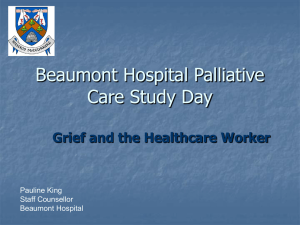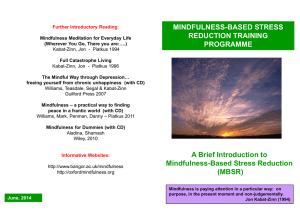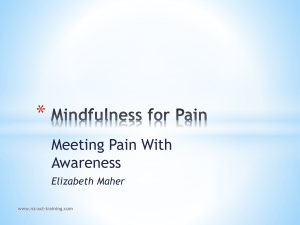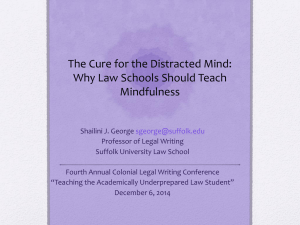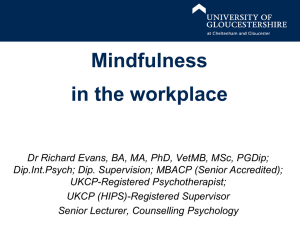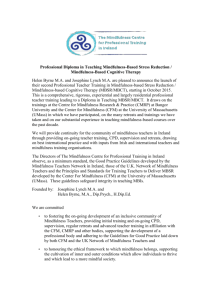Mindfulness in Clinical Practice
advertisement
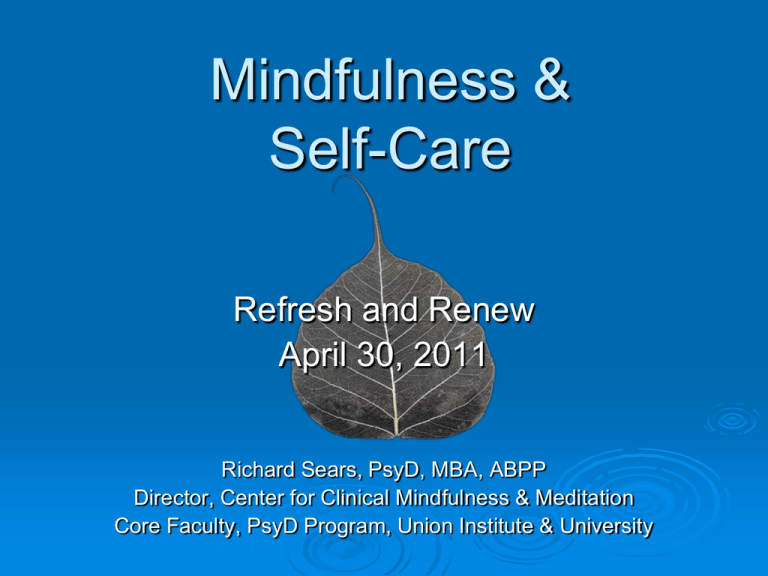
Mindfulness & Self-Care Refresh and Renew April 30, 2011 Richard Sears, PsyD, MBA, ABPP Director, Center for Clinical Mindfulness & Meditation Core Faculty, PsyD Program, Union Institute & University The Nature of Stress Goal is not zero stress, but to find balance Stress Response Release of adrenalin & cortisol Increased Reduced heart rate & blood pressure blood flow for digestion Increased blood flow to major muscles Stress Response Stress response for short-term emergencies is good – countered by relaxation response Chronic stress causes many problems – overwhelms natural balance systems Up to 90% of doctor’s visits are for conditions in which stress at least plays a role Nature of Stress Stress alone does not cause disease Makes you more vulnerable to disease Makes current conditions worse 5 Ways to Well-Being Connect… Be active… Take notice… Keep Learning… Give… centre for well-being, nef (the new economics foundation) 5 Ways to Well-Being Connect… With the people around you. With family, friends, colleagues and neighbours. At home, work, school or in your local community. Think of these as the cornerstones of your life and invest time in developing them. Building these connections will support and enrich you every day. 5 Ways to Well-Being Be active… Go for a walk or run. Step outside. Cycle. Play a game. Garden. Dance. Exercising makes you feel good. Most importantly, discover a physical activity you enjoy; one that suits your level of mobility and fitness. 5 Ways to Well-Being Take notice… Be curious. Catch sight of the beautiful. Remark on the unusual. Notice the changing seasons. Savour the moment, whether you are on a train, eating lunch or talking to friends. Be aware of the world around you and what you are feeling. Reflecting on your experiences will help you appreciate what matters to you. 5 Ways to Well-Being Keep Learning… Try something new. Rediscover an old interest. Sign up for that course. Take on a different responsibility at work. Fix a bike. Learn to play an instrument or how to cook your favourite food. Set a challenge you will enjoy achieving. Learning new things will make you more confident, as well as being fun to do. 5 Ways to Well-Being Give… Do something nice for a friend, or a stranger. Thank someone. Smile. Volunteer your time. Join a community group. Look out, as well as in. Seeing yourself, and your happiness, linked to the wider community can be incredibly rewarding and will create connections with the people around you. What is Mindfulness? Historical Perspectives Present in many cultures Eastern Wisdom Traditions Siddharta Gautama - 8 levels of samadhi (absorption) - Added insight meditations What is Mindfulness? “the awareness that emerges through paying attention on purpose, in the present moment, and nonjudgmentally to the unfolding of experience moment to moment” (Kabat-Zinn, 2003, p. 145) What is Mindfulness? Mechanisms Worry/rumination Negative Reinforcement Exposure Therapy Decentering/Defusion Need for Systematic Training Homework practice Journal What is Mindfulness? Being vs. Doing Being: Present focused Doing: Future focused What is Mindfulness? Differences Transcendental/Absorption Hypnosis Relaxation Methods Meditation What is Mindfulness? Mindfulness-Based Stress Reduction (MBSR) Mindfulness-Based Cognitive Therapy (MBCT) Dialectical Behavioral Therapy (DBT) Acceptance and Commitment Therapy (ACT) Mindfulness-Based Relapse Prevention (MBRP) Mindfulness-Based Eating Awareness Training Mindfulness-Based Elder Care (MBEC) Mindfulness-Based Childbirth & Parenting (MBCP) 3-Minute Breathing Space Essence of MBSR/MBCT program: Body Scan Mindfulness of Breath Mindfulness of Body as a Whole Mindfulness of Thoughts 3-Minute Breathing Space 1 – “Tuning In” Notice what is here Minute Body sensations Feelings Thoughts Let go of judgments, as best you can “it’s already here, just let me feel it” 3-Minute Breathing Space 2 – “Gathering” Focus on the breath Minute Pay attention to one spot – rising and falling of abdomen, nostrils, etc Mind wanders, just gently bring it back, again and again 3-Minute Breathing Space Minute 3 – Expand awareness Expand from breath to body-as-a-whole Obstacles to Self Care Time Priorities Focus on others Not feeling that we are worth it Bringing mindfulness into daily life Self-monitoring Take a breath, take a break Become aware of thoughts/feelings/sensations throughout the day Leaving issues at work Noticing tension in your body Noticing feelings and thoughts “how interesting, there you are again” Investigating vs. Letting Go Insomnia by Billy Collins Even though the house is deeply silent and the room, with no moon, is perfectly dark, even though the body is a sack of exhaustion inert on the bed, someone inside me will not get off his tricycle, will not stop tracing the same tight circle on the same green threadbare carpet. It makes no difference whether I lie staring at the ceiling or pace the living room floor, he keeps on making his furious rounds, little pedaler in his frenzy, my own worst enemy, my oldest friend. Insomnia by Billy Collins What is there to do but close my eyes and watch him circling the night, schoolboy in an ill-fitting jacket, leaning forward, his cap on backwards, wringing the handlebars, maintaining a certain speed? Does anything exist at this hour in this nest of dark rooms but the spectacle of him and the hope that before dawn I can lift out some curious detail that will carry me off to sleepthe watch that encircles his pale wrist, the expandable band, the tiny hands that keep pointing this way and that. Mindful Stress Reduction Groups Based on MBSR & MBCT 8 sessions, 90 minutes each Mindful Stress Reduction Class consists of discussions of stress, anxiety, & depression Practice of mindfulness exercises Discussions of how to apply this to daily life Not required to disclose personal info Mindful Stress Reduction 30 minutes of homework required each day between classes Practice exercises on CD Practice daily activities mindfully Mindfulness for providers significant declines in stress, negative affect, rumination, state and trait anxiety significant increases in positive affect and self-compassion. (Shapiro, Brown, & Biegel, 2007) Mindfulness for providers Training in mindfulness increases provider effectiveness and patient mental health, even if providers do not explicitly use it with patients (Grepmair et al. 2007). Loving-kindness meditation Suggested Readings Full Catastrophe Living (MBSR) Jon Kabat-Zinn The Mindful Way through Depression Williams, Teasdale, Segal, & Kabat-Zinn Mindfulness in Clinical Practice Sears, Tirch, & Denton – forthcoming from Professional Resource Press Contact Richard Sears www.psych-insights.com 513-487-1196 Alliance Institute for Integrative Medicine www.myhealingpartner.com 513-791-5521

